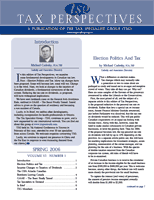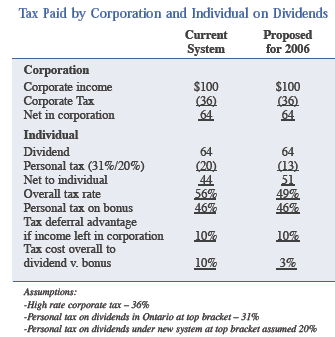
PDF Format
 Issue Contents Issue Contents
 All Issues All Issues
Spring 2006
Volume 6, Number 1
The information in Tax Perspectives is prepared for general interest only. Every effort has been made to ensure that the contents are accurate. However, professional advice should always be obtained before acting and TSG member firms cannot assume any liability for persons who act on the basis of information contained herein without professional advice.
Surprise Changes to Taxation Of Dividends
The Federal Government's surprise announcement of November 23, 2005, lowering the personal tax rate on certain Canadian dividends will, if enacted, have far-reaching implications. The change will fundamentally alter many tax planning arrangements currently in place. Proposed Changes It is proposed that dividends paid by Canadian public companies and by Canadian private companies, where income (other than investment income) was subject to tax at the full corporate tax rate, will be subject to a distinct and preferential gross-up and tax credit mechanism. At present, Canadian taxable dividends are subject to tax at between 25% and 33%, depending on the province, for an individual in the top tax bracket. For eligible dividends, commencing in 2006, the personal tax rate will drop to around 20%. It appears that this proposal has not been discussed with the provinces, let alone approved by them. It is possible that the provinces could adopt different positions and not accept the provincial share of the rate reduction. Eligible Dividends The Federal Government materials did not elaborate on what will constitute an eligible dividend for this purpose. However, based on the "Backgrounder" issued with Minister Goodale's statement, eligible dividends seem to comprise: - dividends from Canadian public companies paid after 2005;
- dividends from Canadian private companies, including Canadian-controlled private companies (CCPCs), where tax has been paid at the high Federal corporate tax rate (around 33% including provincial tax), but excluding dividends paid from investment income of CCPCs.
The exact design of the system will require considerable thought. A number of issues immediately come to mind.For public companies, must full tax be paid in Canada on earnings, before such earnings qualify for payment of eligible dividends? If the tax paid on the earnings is insufficient, because of incentive depreciation, investment tax credits from scientific research and experimental development, or foreign tax credits, will the dividends still qualify? Moreover, if income is earned in a foreign subsidiary, and is not taxable to the Canadian parent when paid as a dividend from exempt surplus, would the income still qualify for the payment of eligible dividends? How will the system be phased in? Will the system only apply to income earned after 2005, or to all retained earnings, whenever earned? For Canadian private companies, it seems from the Backgrounder that further restrictions will apply, e.g. that tax must be paid by the corporation at the high Federal corporate tax rate. What if some income is subject to tax at the high rate, while other income is taxed at the small business rate? Clearly there will have to be a segregation and an apportionment of income earned from different sources. If there are two pots of dividends, will there be an ordering of dividend payments? Are eligible dividends paid first, for example? The system will be complex to design and even more complex for the accountants who will be required to keep everything in order. Implications The impact of the new system will depend, in part, on how the new system is implemented. Here are some points to consider: - If the system is designed so that a corporation may have eligible and non-eligible retained earnings, it may be beneficial to stream dividends into eligible and non-eligible components. One could imagine creating two classes of shares, one on which eligible dividends would be paid and the other on which taxable dividends (the current system) would be paid. Corporations, especially if public, may consider reorganizing their share capital into two classes to achieve the two dividend streams. Canadian individuals will obviously prefer eligible dividends, while tax-exempt entities (such as pension funds, RRSPs, etc.) and non-residents will be indifferent, and thus may be paid non-eligible dividends.
- It has been traditional to pay owner/managers a bonus, to reduce the income of CCPCs which carry on an active business to the small business limit (currently $300,000 federally). Otherwise, significant double taxation will arise when the earnings are distributed by way of dividends. Calculations indicate that double tax will be significantly less under the new system (possibly about a 3% tax penalty in respect of the distribution of dividends from high rate income). Serious consideration will now have to be given to retaining income in the corporation, even if subject to tax at the highest corporate tax rate, if funds are not required personally by the shareholders. Depending on the top personal tax rate in the province of residence of the shareholder, there will be a tax deferral of, roughly speaking, between 4% and 12% by retaining funds in the corporation. Faced with only a small additional tax cost on dividends when they are later paid, the immediate tax deferral will likely be persuasive to many.
- In the past, it was often beneficial for a corporation earning rental income or royalties to be characterized as a specified investment business (SIB). This required that there be less than 6 full time employees in the corporate group. By doing so, a tax refund of 26-2/3% is obtained on payment of dividends to shareholders. This is designed to eliminate double tax, once in the corporation and then at the personal level. But SIB income retained in the corporation is subject to a corporate tax rate of about 49% versus around 36% for active income. There may no longer be an advantage to qualifying as a SIB. Active business income will be preferred.
- Under the current system, the tax rate on dividends exceeds the tax rate on capital gains (31% v. 23% for an Ontario resident in the top tax bracket). Thus, there is a bias towards structuring the sale of a business so that the gain is taxable as a capital gain. Under the new system, at least to the extent of retained earnings which may be paid out as eligible dividends, the situation will be reversed.
- On death, it is common to consider a wind-up of a private company to prevent double tax from occurring at a future date on a subsequent sale. If completed within one year of the date of death, a capital loss so created may be claimed on the final tax return of the deceased.
 However, this normally results in the capital gain at death being converted into a dividend, taxable at a rate 5% to 9% above the rate on a capital gain. Thus this planning was often not carried out because of this additional tax cost. For eligible dividends after 2005, the lower tax rate will make this type of post mortem estate planning more important and beneficial. However, this normally results in the capital gain at death being converted into a dividend, taxable at a rate 5% to 9% above the rate on a capital gain. Thus this planning was often not carried out because of this additional tax cost. For eligible dividends after 2005, the lower tax rate will make this type of post mortem estate planning more important and beneficial. - Techniques for estate freezes and overall remuneration strategies for owners of private businesses will need to be re-examined and perhaps modified. Estate freezes combined with share redemptions may prove very beneficial.
- Insurance is often used to fund the tax payable at death. Since the optimal tax arrangements for estate planning are likely to change, insurance requirements may also change.
Conclusion The proposed change to the tax treatment of dividends will have far-reaching implications for Canadian tax planning, well beyond what one might have initially believed. The changes do far more than merely equalize the overall tax paid on corporate dividends to that of income trusts. We shall have to wait for draft legislation before the full impact of this change will be known. Two things are certain. If the new system comes about, it will be complex and the impact will be considerable.
|